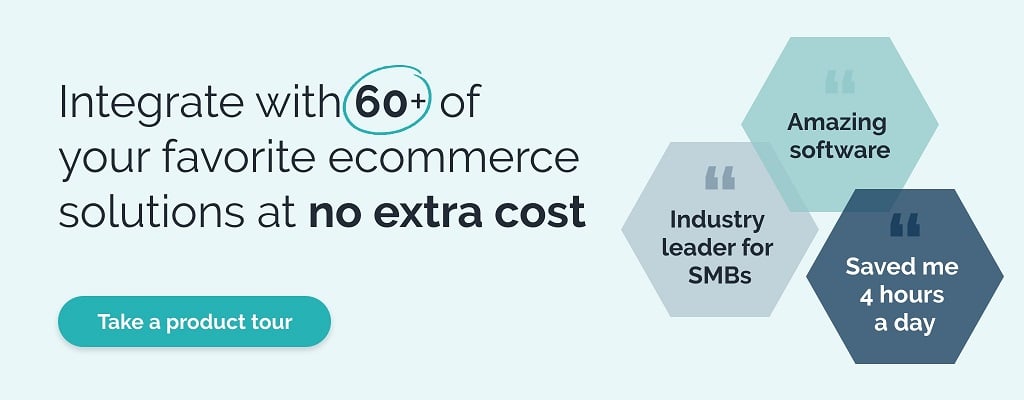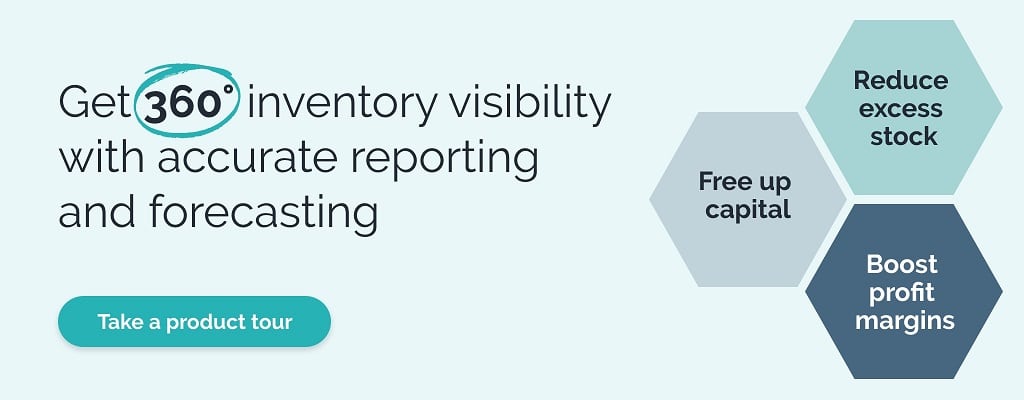
A well-developed sourcing strategy can make a massive difference in your bottom line.
To make things easier, this post will break down everything involved with sourcing – from finding products to finding the best people to buy those products from to the delivery types involved from sourced supplier to customer.
Creating a seamless pipeline to procure and bring these products to consumers will keep your sales process functioning efficiently.
Let’s dive right in!
What is Sourcing?
In inventory management, sourcing refers to identifying, evaluating, and establishing a relationship with suppliers or manufacturers who can provide the goods or raw materials needed for a business.
This includes determining the most cost-effective and reliable sources for these items, negotiating terms and prices, and managing the ordering and delivery process to ensure a consistent and efficient inventory flow to meet business demands.
What is procurement, and what does it have to do with sourcing?
Procurement is obtaining goods and services a business needs to carry out its operations.
It involves activities such as identifying needs, sourcing suppliers, negotiating prices, agreeing on contracts, and managing supplier relationships to ensure the timely delivery of quality goods and services.
On the other hand, sourcing is a component of the procurement process that specifically focuses on identifying suitable suppliers or vendors who can provide the necessary goods or services and establishing relationships with these suppliers.
Sourcing and procurement are closely interlinked and crucial to effective supply chain management.

Why Is Sourcing Important?
Supply chains would not exist without sourcing. How can you sell what you don’t have?
Aside from that obvious point, here are some reasons sourcing is essential.
Cost Management
Strategic sourcing provides benefits for both buyers and suppliers. Buyers can typically negotiate lower unit pricing for high-volume purchasing.
This reduces the costs of goods and keeps retail prices competitive. Suppliers benefit because they have a consistent outlet for their goods, making planning and cash flow more dependable.
Stability
When you find the right source for your products, it truly becomes a partnership. Both businesses rely on each other to keep the supply chain intact.
Developing a close relationship can lead to higher quality (and efficiency) as suppliers and customers work together to identify and minimize the root causes of defects that hurt both buyer and seller.
Managing Risk
Besides identifying and solving problems, a strong relationship built of trust can help mitigate risk. When both parties know they can depend on each other, it opens the door to honest conversation.
For example, if one party has temporary cash flow concerns, it can be discussed openly. This lowers the risk for both parties.
How to Get Started with Sourcing
If companies handle the sourcing themselves, there’s no shortcut. Choosing a supplier requires proper research and strategy.
Selecting a Supplier
Selecting a supplier as the source for your goods means investing the time and effort to get to know them and ask the tough questions.
After all, you’ll be delivering these products to your customers – your business’s reputation is at stake. Companies need to do business with suppliers to ensure their products deliver the best results.
WHAT TO LOOK FOR WHEN CHOOSING A SUPPLIER
Here are some characteristics to look for when selecting a supplier:
- Years of experience
- Flexibility in changed order times
- Wide range of available products and/or services
- Negotiable prices
- Customer reviews
- Prompt delivery times
- Accommodating customer service
- Financial stability
It’s important to remember that when you’re choosing a vendor, you’re choosing a business partner. This needs to be someone you can trust and someone you can rely on now and in the future.
Vendors make a monumental impact on your business, so choose wisely.
Securing a Supplier
If you can visit a supplier in person, your chances of securing that vendor grow exponentially.
Whether that’s a possibility or not, here are a few of the critical steps to consider when researching and securing a supplier:
DO YOUR RESEARCH
Start by doing online searches of the supplier’s reputation. You can check the Better Business Bureau, local Chambers of Commerce in areas where they do business, and online search engines for customer complaints.
These can provide important clues and provide areas to probe.
Checking vendor social media accounts can be enlightening. Customers aren’t shy about leaving negative comments online.
Be sure to verify registrations, business licenses, and any required certifications. There are a lot of shady operators out there and you want to ensure you won’t get burned.
NEGOTIATE A FAIR DEAL
Supplier negotiation goes beyond price haggling and requires balancing your needs with the supplier’s.
Research your market, budget, and product value to strengthen your negotiation position.
Promote transparency by discussing your requirements, volumes, timelines, and quality expectations upfront. Understand the supplier’s constraints like minimum order quantities or lead times, and work together for a solution.
A good negotiation forms the foundation of a supplier relationship that benefits your business in the long term.
SPECIFY DELIVERY EXPECTATIONS
The importance of a strong supplier-to-business relationship applies to delivery times as well. Depending on your business structure and needs, there are various options.
In negotiating an agreement, discuss your needs fully. You may find the supplier is unable to meet your needs.
You may also be able to negotiate better pricing or terms by adapting your delivery expectations to work the way the supplier prefers. If you have flexibility in your supply chain or timeline, you may be able to conclude a better deal.
Managing your inventory effectively helps reduce your holding costs and tie up capital that could be used elsewhere in your business.
Whether you choose continuous replenishment, just-in-time inventory, or on-demand delivery, all require the cooperation of reliable businesses and suppliers.

Understand Supplier Delivery Models
CONTINUOUS REPLENISHMENT MODEL
In the continuous replenishment model, suppliers make deliveries off a predetermined schedule, often in short periods, based on a company’s inventory data and/or real-time demand.
When companies employ continuous replenishment, they encourage reduced inventory levels because they’re ordering in small batches rather than large batches, which are more costly and reduce suppliers’ flexibility.
Depending on the supplier, more frequent but consistent deliveries may be preferable. For others, they may be more costly and can increase your price.
JUST-IN-TIME DELIVERY MODEL
Under a just-in-time delivery model, companies receive supplies on an as-needed basis. In doing so, they reduce inventory levels and costs because just in time deliver only what is needed to increase efficiency and decrease excess waste.
With the help of inventory management software, you can better predict inventory demand with forecasting tools to have the right amount of goods.
ON-DEMAND DELIVERY MODEL
In an on-demand delivery model, suppliers deliver goods when the customer demands. This gives you the flexibility to wait to take delivery – and trigger payment – until your stock reaches the level where it’s time to reorder.
In this model, it’s especially to choose a supplier with plenty of products and flexibility when order times change rapidly.
If a company demands it, the supplier must be ready and timely with prompt delivery.
Create a Contract

Once you’ve negotiated the terms, it’s time to draw up a contract. Don’t skimp on an attorney. If you make a mistake or leave it up to the supplier, you may limit your recourse should anything go wrong.
Oral agreements or invoices leave room for error. While they may have some enforceability, proving it may be expensive and time-consuming if you ever need legal action.
Write a written contract that includes all parties involved, establish payment terms, and commit to any important details, such as timely delivery.
A standard contract should cover what’s expected and what happens when one party fails to live up to the agreement.
WHAT TO INCLUDE IN YOUR CONTRACT
A vendor contract should cover the following:
- Details of the work the supplier agrees to provide
- The quality of the supplied goods or provided services
- Length of the contract term
- Payment terms
- Indemnity, in the event of loss arising from negligence
- What actions can be taken in case of a breach
A contract is only legally enforceable after both the customer and supplier sign it demonstrating an agreement to live up to its terms and conditions. Besides legal reasons, it’s also important to establish a relationship built upon mutual expectations.
Typically, the customer includes a statement within the agreement describing the goods’ quality and quantity. Payments made to the supplier are based on the successful fulfillment of this statement.
Common Questions About Sourcing and Supply Chain Management
Here are the answers to a few common questions when you start sourcing.
What’s a good way to find quality suppliers in the sourcing process?
There are several ways to start the sourcing process. Some companies will look first to companies that have good reputations in their particular industry and see how they use as suppliers.
They also solicit referrals from others in the business. Check industry publications, industry trade organizations, and trade shows for sources.
You can usually count on the industry-leading suppliers to be tried-and-true, but you may also be paying for a name. Regardless of who you source, do your due diligence to make sure they are who they say they are.
And, remember the saying: if it seems too good to be true, it probably is.
What is tactical sourcing?
Tactical sourcing, or spot buying, is a procurement strategy focusing on short-term, transactional purchases to meet specific needs.
Unlike strategic sourcing, which involves long-term relationships and contracts with suppliers, tactical sourcing is often used for one-time purchases or when immediate needs arise.
It involves quickly identifying and engaging with suppliers who can meet the demand, negotiating the terms, and executing the purchase.
While tactical sourcing can efficiently address immediate needs or items with low spending, it may not provide the same level of cost control, supplier relationship management, or overall value as strategic sourcing.
However, it’s important to note that strategic and tactical sourcing have their own advantages and should be used according to a business’s specific needs and situations.
What is a procurement team?

A procurement team is a group of professionals within an organization responsible for acquiring or procuring the goods and services needed to achieve business goals.
Procurement departments are pivotal in managing and optimizing the purchasing process, which involves supplier selection, negotiation, contract management, and supply chain management.
The specific roles and responsibilities within a procurement team can vary depending on the size and nature of the business.
For instance, smaller businesses might have a single person or a small team handling procurement alongside other duties.
In larger organizations, the procurement department might include specialists responsible for different parts of the process like strategic sourcing, contract management, supplier relationship management, and risk management.
How do I know if I need a sourcing and procurement team?
Whether or not you need a procurement team depends on your business’s size, complexity, and operational requirements. Here are a few things to consider:
- Size and Complexity: Larger businesses or those with a high degree of complexity in their operations or product lines often benefit from having a dedicated procurement team. They can help manage a broad network of suppliers, handle complex contracts, and deal with logistical challenges.
- Cost Efficiency: A sourcing team can bring significant cost savings to your business by negotiating better terms with suppliers, reducing waste, and identifying opportunities for bulk purchasing or long-term contracts.
- Risk Management: Procurement professionals can also help manage risks such as supply chain disruptions, non-compliance issues, and price volatility, which could significantly impact your business.
- Strategic Sourcing: A dedicated team can focus on strategic sourcing, ensuring your business works with the best possible suppliers for quality, price, and reliability. They can also build strong relationships with these suppliers, which can be beneficial in the long run.
Subscribe and receive tips that build trust with and delight your buyer
Should I ask for references?
Yes. You can learn a lot about potential suppliers from their customers.
While you can expect any references they give you will likely say good things about them, it allows you to discuss with a neutral party to see if the source is a good fit for how you do business.
You should also ask for product samples. This gives you a way to see first-hand how a company fulfills an order, the quality of the product they provide, and the way it’s packaged.
What are the other parts of the supply chain process?
The supply chain process is a complex network that includes many activities, people, entities, and resources, all of which must work harmoniously to bring a product or service from the supplier to the customer.
After sourcing, which is the initial step, the following components form the integral parts of the supply chain management process:
- Procurement: After sourcing, procurement is the process of purchasing the sourced goods and services. It involves negotiating contracts, issuing purchase orders, and ensuring timely payments.
- Inventory Management: This involves keeping track of the products on hand and understanding how quickly they turn over. Effective inventory management helps minimize costs and ensures that enough products are available to meet demand, but not so many that they take up too much space or resources.
- Warehousing and Storage: This stage involves storing the procured goods safely and organized, ensuring that they are easily accessible and retrievable when needed.
- Demand Planning and Forecasting: This predictive process helps businesses anticipate the demand for their products and plan accordingly. It uses historical data and market insights to estimate future demand.
- Order Fulfillment: This process includes receiving, processing, and delivering customer orders. It requires coordination between the warehouse, shipping carriers, and customer service.
- Logistics and Distribution: In this stage, goods are transported from the warehouse to retail locations or directly to consumers. It can involve complex coordination of various transportation modes and routes.
- Returns Management: Also known as reverse logistics, this involves handling returned products, determining their disposition (such as restock, recycle, or dispose), and managing refunds or exchanges.
- Customer Service: This final component involves resolving customer queries, handling complaints, and ensuring customer satisfaction after the sale.
Each of these steps in the process is interrelated and can significantly influence a business’s success and customer satisfaction.
Are there different types of sourcing?

Depending on the goods you are trying to procure, you may work directly with manufacturers, source from distributors, or use wholesalers. Here are sourcing examples of how these relationships might work:
- Working directly with manufacturing companies cuts out the middleman and may allow you to get products at the most affordable price. However, not every manufacturer will work with every vendor directly, or they may have MOQs that exceed your abilities.
- Working with a wholesaler may allow you to get products from multiple vendors. That way, if a particular manufacturer cannot provide you with what you need, they can still fulfill your order by switching to another vendor. You will pay a markup on goods to work through a wholesaler, but you’ll also get better pricing than through the open market – unless you can buy direct.
- Some manufacturers only sell through distributors. If so, ask the manufacturer for a list of recommended distributors to ensure you can trust the supply chain.
What are some best practices for global sourcing?
Global sourcing is the practice of procuring goods and services across geopolitical boundaries. It’s an effective way to gain competitive advantages, such as cost reduction, accessing global talent, and improving processes.
However, it also comes with challenges, including language barriers, cultural differences, and logistical issues. Here are some best practices for successful global sourcing:
- Understand the Market: Understanding the international markets from where you’re sourcing is crucial. This includes knowledge of local business customs, currency exchange rates, and economic stability.
- Ensure Regulatory Compliance: Compliance with international laws and regulations is essential in global sourcing. Every country has its own set of rules regarding imports, exports, and business operations. Non-compliance can result in hefty fines, legal action, and damage to your business reputation. Hiring legal help or consulting a specialist is advisable to ensure you meet all regulatory compliance requirements.
- Establish Clear Communication: Clear communication is critical due to the potential language and cultural barriers. Ensure that all expectations, including product specifications, delivery schedules, and quality standards, are clearly defined and understood by both parties.
- Develop Strong Supplier Relationships: Building strong relationships with your suppliers can lead to better negotiation power, improved quality, and reliable delivery schedules.
- Risk Management: Understand the potential risks involved in international sourcing and implement a mitigation strategy. This could involve diversifying your supplier base or having backup plans in case of supply chain disruptions.
- Use Technology: Procurement software can help streamline the sourcing process, improve communication, and provide valuable insights into supplier performance.
- Sustainable Procurement: Consider the social and environmental impact of your sourcing decisions. Opting for sustainable suppliers can improve brand reputation and customer loyalty.
Successful global sourcing is about much more than finding the lowest cost. It involves careful planning, strong relationship building, and strict adherence to quality standards and regulatory compliance.

What Else Should I know?
Keeping your shelves stocked with the right number of products is the goal. If you have too many products in your warehouse, you increase your holding costs and risk getting stuck with products that aren’t selling. Too few products on the shelves can lead to stock-outs and frustrated customers.
Creating a strong supply chain means managing your existing and potential suppliers, in addition to your inventory. Using procurement software like SkuVault gives you access to real-time information to manage your stock accurately.
You can track your suppliers and automate reordering when stock levels fall to pre-set limits. You can manage the safety stock you need to maintain until replacement products arrive. And you can use reports, such as the replenishment report, to make better business decisions.
Final Thoughts
Sourcing suitable suppliers will take an investment upfront but it’s key to creating an efficient supply chain.
Think about it this way: you shouldn’t rush into a long-term, committed relationship (either personally or professionally). The same logic applies to supplier relationships.
Take your time, consider your sourcing strategy and business processes, and prioritize sustainable procurement partners – not one-off relationships.
Developing a strategic sourcing process is crucial to any organization’s supply chain.
It’s just the beginning of the supply chain as you lock in vendors that can provide the quality of goods you need at a price that works for your business.
We’ve all seen what happens when the supply chain breaks down. It leads to lost sales, unhappy customers and can damage a company’s reputation.
Take the time to vet suppliers in your sourcing process thoroughly. It will pay off in the long run – and maybe in the short term, as well.

